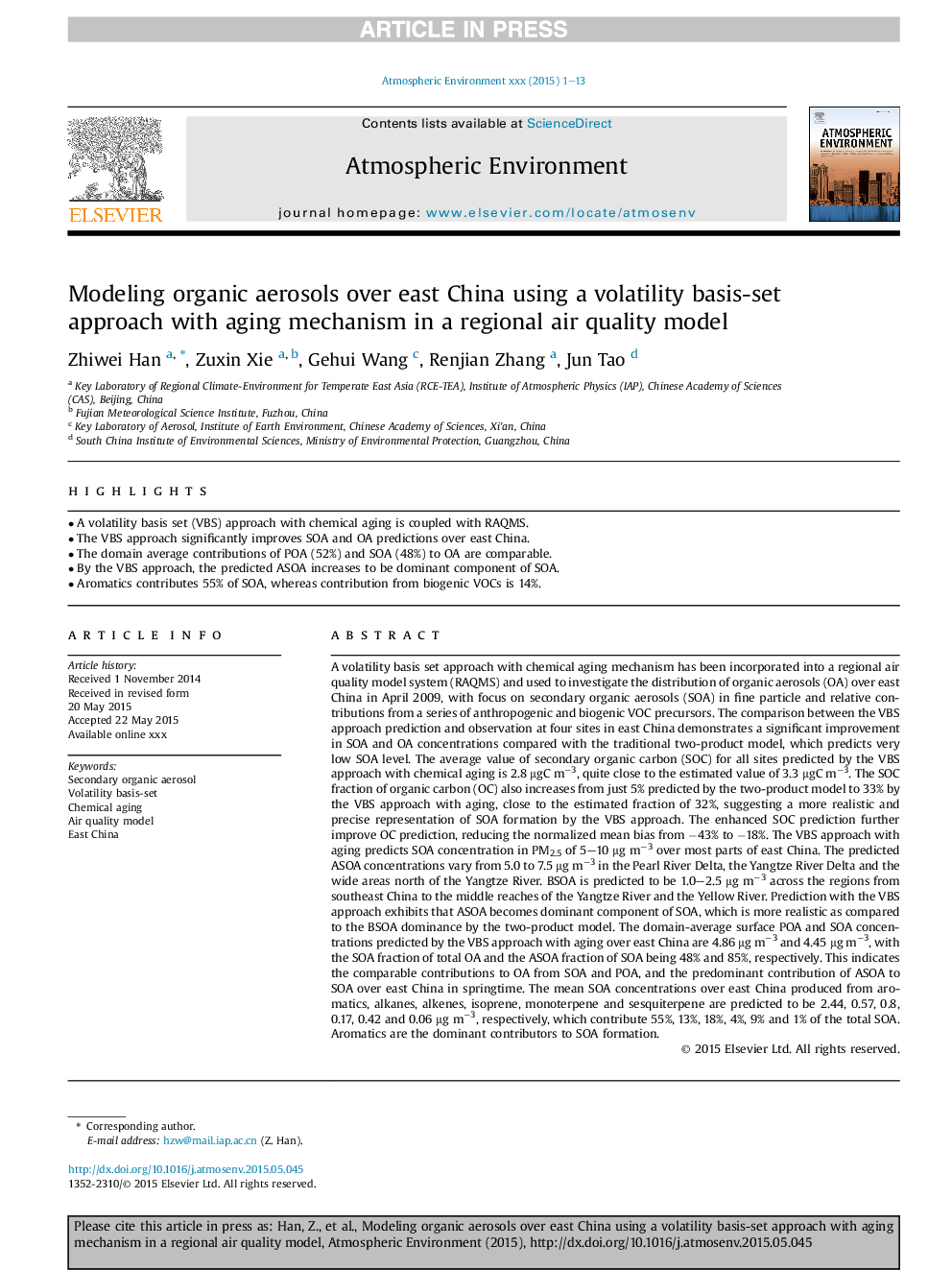| کد مقاله | کد نشریه | سال انتشار | مقاله انگلیسی | نسخه تمام متن |
|---|---|---|---|---|
| 6337441 | 1310936 | 2016 | 13 صفحه PDF | دانلود رایگان |
عنوان انگلیسی مقاله ISI
Modeling organic aerosols over east China using a volatility basis-set approach with aging mechanism in a regional air quality model
ترجمه فارسی عنوان
مدل سازی آئروسل های آلی در شرق چین با استفاده از یک روش مبتنی بر نوسانات با مکانیزم پیری در یک مدل کیفیت هوا منطقه ای
دانلود مقاله + سفارش ترجمه
دانلود مقاله ISI انگلیسی
رایگان برای ایرانیان
کلمات کلیدی
آرسنیک آلی متوسط، نوسانات پایه مجموعه، پیری شیمیایی، مدل کیفیت هوا، شرق چین،
موضوعات مرتبط
مهندسی و علوم پایه
علوم زمین و سیارات
علم هواشناسی
چکیده انگلیسی
A volatility basis set approach with chemical aging mechanism has been incorporated into a regional air quality model system (RAQMS) and used to investigate the distribution of organic aerosols (OA) over east China in April 2009, with focus on secondary organic aerosols (SOA) in fine particle and relative contributions from a series of anthropogenic and biogenic VOC precursors. The comparison between the VBS approach prediction and observation at four sites in east China demonstrates a significant improvement in SOA and OA concentrations compared with the traditional two-product model, which predicts very low SOA level. The average value of secondary organic carbon (SOC) for all sites predicted by the VBS approach with chemical aging is 2.8 μgC mâ3, quite close to the estimated value of 3.3 μgC mâ3. The SOC fraction of organic carbon (OC) also increases from just 5% predicted by the two-product model to 33% by the VBS approach with aging, close to the estimated fraction of 32%, suggesting a more realistic and precise representation of SOA formation by the VBS approach. The enhanced SOC prediction further improve OC prediction, reducing the normalized mean bias from â43% to â18%. The VBS approach with aging predicts SOA concentration in PM2.5 of 5-10 μg mâ3 over most parts of east China. The predicted ASOA concentrations vary from 5.0 to 7.5 μg mâ3 in the Pearl River Delta, the Yangtze River Delta and the wide areas north of the Yangtze River. BSOA is predicted to be 1.0-2.5 μg mâ3 across the regions from southeast China to the middle reaches of the Yangtze River and the Yellow River. Prediction with the VBS approach exhibits that ASOA becomes dominant component of SOA, which is more realistic as compared to the BSOA dominance by the two-product model. The domain-average surface POA and SOA concentrations predicted by the VBS approach with aging over east China are 4.86 μg mâ3 and 4.45 μg mâ3, with the SOA fraction of total OA and the ASOA fraction of SOA being 48% and 85%, respectively. This indicates the comparable contributions to OA from SOA and POA, and the predominant contribution of ASOA to SOA over east China in springtime. The mean SOA concentrations over east China produced from aromatics, alkanes, alkenes, isoprene, monoterpene and sesquiterpene are predicted to be 2.44, 0.57, 0.8, 0.17, 0.42 and 0.06 μg mâ3, respectively, which contribute 55%, 13%, 18%, 4%, 9% and 1% of the total SOA. Aromatics are the dominant contributors to SOA formation.
ناشر
Database: Elsevier - ScienceDirect (ساینس دایرکت)
Journal: Atmospheric Environment - Volume 124, Part B, January 2016, Pages 186-198
Journal: Atmospheric Environment - Volume 124, Part B, January 2016, Pages 186-198
نویسندگان
Zhiwei Han, Zuxin Xie, Gehui Wang, Renjian Zhang, Jun Tao,
